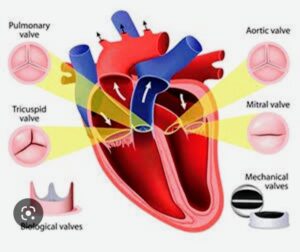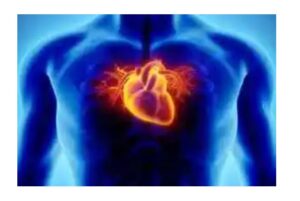

Heart disease describes a range of conditions that affect the heart.
It also refers to several types of heart conditions. The most common type of heart disease in the United States is coronary artery disease (CAD), which affects the blood flow to the heart. Decreased blood flow can cause a heart attack.
Heart diseases include: Blood vessel disease, such as coronary artery disease,Irregular heartbeats (arrhythmias), Heart problems you’re born with (congenital heart defects) Disease of the heart muscle and Heart valve disease.
Many forms of heart disease can be prevented or treated with healthy lifestyle choices.
Coronary artery disease is a common heart condition that affects the major blood vessels that supply the heart muscle. Cholesterol deposits (plaques) in the heart arteries are usually the cause of coronary artery disease. The buildup of these plaques is called atherosclerosis (ath-ur-o-skluh-ROE-sis). Atherosclerosis reduces blood flow to the heart and other parts of the body. It can lead to a heart attack, chest pain (angina) or stroke.
Coronary artery disease symptoms may be different for men and women. For instance, men are more likely to have chest pain. Women are more likely to have other symptoms along with chest discomfort, such as shortness of breath, nausea and extreme fatigue.
SYMPTOMS OF CORONARY ARTERY DISEASE CAN INCLUDE:
Chest pain, chest tightness, chest pressure and chest discomfort (angina)
Shortness of breath, Pain in the neck, jaw, throat, upper belly area or back Pain, numbness, weakness or coldness in the legs or arms if the blood vessels in those body areas are narrowed you might not be diagnosed with coronary artery disease until you have a heart attack, angina, stroke or heart failure. It’s important to watch for heart symptoms and discuss concerns with your health care provider. Heart (cardiovascular) disease can sometimes be found early with regular health checkups.
What is coronary artery disease? A Mayo Clinic cardiologist explains.
Heart disease symptoms caused by irregular heartbeats (heart arrhythmias)
The heart may beat too quickly, too slowly or irregularly. Heart arrhythmia symptoms can include:
Chest pain or discomfort
Dizziness
Fainting (syncope) or near fainting
Fluttering in the chest
Lightheadedness
Racing heartbeat (tachycardia)
Shortness of breath
Slow heartbeat (bradycardia)
Heart disease symptoms caused by congenital heart defects
Serious congenital heart defects usually are noticed soon after birth.
Congenital heart defect symptoms in children could include:
Pale gray or blue skin or lips (cyanosis)
Swelling in the legs, belly area or areas around the eyes.
In an infant, shortness of breath during feedings, leading to poor weight gain
Less-serious congenital heart defects are often not diagnosed until later in childhood or during adulthood.
Symptoms of congenital heart defects that usually aren’t immediately life-threatening include:
Easily getting short of breath during exercise or activity
Easily tiring during exercise or activity
Swelling of the hands, ankles or feet
Heart disease symptoms caused by diseased heart muscle (cardiomyopathy)
Early stages of cardiomyopathy may not cause noticeable symptoms. As the condition worsens, symptoms may include:
Dizziness, lightheadedness and fainting
Fatigue
Feeling short of breath during activity or at rest
Feeling short of breath at night when trying to sleep or waking up short of breath
Irregular heartbeats that feel rapid, pounding or fluttering
Swollen legs, ankles or feet
Heart disease symptoms caused by heart valve problems (valvular heart disease)
The heart has four valves — the aortic, mitral, pulmonary and tricuspid valves. They open and close to move blood through the heart. Many things can damage the heart valves. A heart valve may become narrowed (stenosis), leaky (regurgitation or insufficiency) or close improperly (prolapse).
Valvular heart disease is also called heart valve disease. Depending on which valve isn’t working properly, heart valve disease symptoms generally include:
Chest pain
Fainting (syncope)
Fatigue
Irregular heartbeat
Shortness of breath
Swollen feet or ankles
Endocarditis is an infection that affects the heart valves and inner lining of the heart chambers and heart valves (endocardium). Endocarditis symptoms can include:
Dry or persistent cough
Fever
Heartbeat changes
Shortness of breath
Skin rashes or unusual spots
Swelling of the legs or belly area
Weakness or fatigue
When to see a doctor
Seek emergency medical care if you have these heart disease symptoms:
Chest pain
Shortness of breath
Fainting
Always call 911 or emergency medical help if you think you might be having a heart attack.
Heart disease is easier to treat when detected early. Talk to your health care provider if you have any concerns about your heart health. Together, you and your provider can discuss ways to reduce your heart disease risk. This is especially important if you have a family history of heart disease.
If you think you may symptoms of heart disease, make an appointment to see your provider.
Heart disease causes depend on the specific type of heart disease. There are many different types of heart disease.
How the heart works
The left and right atria and left and right ventricles
Chambers and valves of the heartOpen pop-up dialog box
To understand the causes of heart disease, it may help to understand how the heart works.
The heart is divided into chambers — two upper chambers (atria) and two lower chambers (ventricles).
The right side of the heart moves blood to the lungs through blood vessels (pulmonary arteries).
In the lungs, blood picks up oxygen and then returns to the left side of the heart through the pulmonary veins.
The left side of the heart then pumps the blood through the aorta and out to the rest of the body.
Heart valves
Four heart valves — the aortic, mitral, pulmonary and tricuspid — keep the blood moving the right way. The valves open only one way and only when they need to. Valves must open all the way and close tightly so there’s no leakage.
Heartbeats
A beating heart squeezes (contracts) and relaxes in a continuous cycle.
During contraction (systole), the lower heart chambers (ventricles) squeeze tight. This action forces blood to the lungs and the rest of the body.
During relaxation (diastole), the ventricles fill with blood from the upper heart chambers (atria).
Electrical system
The heart’s electrical system keeps it beating. The heartbeat controls the continuous exchange of oxygen-rich blood with oxygen-poor blood. This exchange keeps you alive.
Electrical signals start in the upper right chamber (right atrium).
The signals travel through specialized pathways to the lower heart chambers (ventricles). This tells the heart to pump.
Causes of coronary artery disease
Development of atherosclerosis
Development of atherosclerosisOpen pop-up dialog box
A buildup of fatty plaques in the arteries (atherosclerosis) is the most common cause of coronary artery disease. Risk factors include a poor diet, lack of exercise, obesity and smoking. Healthy lifestyle choices can help lower the risk of atherosclerosis.
Causes of irregular heartbeats (arrhythmias)
Common causes of arrhythmias or conditions that can lead to them include:
CARDIOMYOPATHY
Coronary artery disease
Diabetes
Drug misuse
Emotional stress
Excessive use of alcohol or caffeine
Heart problem present at birth (congenital heart defects)
High blood pressure
Smoking
Heart valve disease
Use of certain medications, including those bought without a prescription, and herbs and supplements
Causes of congenital heart defects
A congenital heart defect develops while a baby is growing in the womb. A congenital heart defect forms as the baby’s heart develops, about a month after conception. Congenital heart defects change the flow of blood in the heart. Some medical conditions, medications and genes increase the risk of congenital heart defects.
Causes of a thickened or enlarged heart muscle (cardiomyopathy)
The cause of cardiomyopathy depends on the type:
Dilated cardiomyopathy. The cause of this most common type of cardiomyopathy often is unknown. It may be passed down through families (inherited). Dilated cardiomyopathy typically starts in the heart’s main pumping chamber (left ventricle). Many things can cause damage to the left ventricle, including heart attacks, infections, toxins and some drugs, including cancer medicines.
Hypertrophic cardiomyopathy. This type is usually passed down through families (inherited).
Restrictive cardiomyopathy. This is the least common type of cardiomyopathy. It can occur for no known reason. Sometimes it’s caused by a buildup of protein called amyloid in the heart (cardiac amyloidosis) or connective tissue disorders.
Causes of heart infection
A heart infection, such as endocarditis, occurs when germs reach the heart or heart valves.
The most common causes of heart infections are:
Bacteria
Viruses
Parasites
Causes of heart valve disease
Many things can cause diseases of the heart valves. Some people are born with heart valve disease (congenital heart valve disease). Heart valve disease may also be caused by conditions such as:
Rheumatic fever
Infections (infectious endocarditis)
Connective tissue disorders
More Information
Heart disease care at Mayo Clinic
Omega-6 fatty acids
Risk factors
Risk factors for heart disease include:
Age. Growing older increases the risk of damaged and narrowed arteries and a weakened or thickened heart muscle.
Sex. Men are generally at greater risk of heart disease. The risk for women increases after menopause.
Family history. A family history of heart disease increases the risk of coronary artery disease, especially if a parent developed it at an early age (before age 55 for a male relative, such as your brother or father, and 65 for a female relative, such as your mother or sister).
Smoking. If you smoke, quit. Substances in tobacco smoke damage the arteries. Heart attacks are more common in smokers than in nonsmokers. If you need help quitting, talk to your health care provider about strategies that can help.
Unhealthy diet. Diets high in fat, salt, sugar and cholesterol have been linked to heart disease.
High blood pressure. Uncontrolled high blood pressure can cause the arteries to become hard and thick. These changes interrupt blood flow to the heart and body.
High cholesterol. Having high cholesterol increases the risk of atherosclerosis. Atherosclerosis has been linked to heart attacks and strokes.
Diabetes. Diabetes increases the risk of heart disease. Obesity and high blood pressure increase the risk of diabetes and heart disease.
Obesity. Excess weight typically worsens other heart disease risk factors.
Lack of exercises. Being inactive (sedentary lifestyle) is associated with many forms of heart disease and some of its risk factors, too.
Stress. Unrelieved stress may damage the arteries and worsen other risk factors for heart disease.
Poor dental health. It’s important to brush and floss your teeth and gums often. Also get regular dental checkups. Unhealthy teeth and gums makes it easier for germs to enter the bloodstream and travel to the heart. This can cause endocarditis.
Complications
COMPLICATIONS OF HEART DISEASE INCLUDE:
Heart failure. This is one of the most common complications of heart disease. Heart failure occurs when the heart can’t pump enough blood to meet the body’s needs.
Heart attack. A heart attack may occur if a blood clot is stuck in a blood vessel that goes to the heart.
Stroke. The risk factors that lead to heart disease can also lead to an ischemic stroke. This type of stroke happens when the arteries to the brain are narrowed or blocked. Too little blood reaches the brain. A stroke is a medical emergency — brain tissue begins to die within just a few minutes of a stroke.
Aneurysm. An aneurysm is a bulge in the wall of an artery. If an aneurysm bursts, you may have life-threatening internal bleeding.
Peripheral artery disease. In this condition, the arms or legs — usually the legs — don’t get enough blood. This causes symptoms, most notably leg pain when walking (claudication). Atherosclerosis can lead to peripheral artery disease.
SUDDEN CARDIAC ARREST. Sudden cardiac arrest is the sudden loss of heart function, breathing and consciousness. It’s usually due to a problem with the heart’s electrical system. Sudden cardiac arrest is a medical emergency. If not treated immediately, it results in sudden cardiac death.
The same lifestyle changes used to manage heart disease may also help prevent it. Try these heart-healthy tips:
Don’t smoke.
Eat a diet that’s low in salt and saturated fat.
Exercise at least 30 minutes a day on most days of the week.
Maintain a healthy weight.
Reduce and manage stress.
Control high blood pressure, high cholesterol and diabetes.
Get good sleep. Adults should aim for 7 to 9 hours daily.
More to come on heart related diseases …Thank You and God bless









